Austin, where I spent a few days this week, is not yet a great city to bike in. But some of the ideas it’s developed in its bid to become one are useful, and here’s one.
Crosswalk curb extensions are great. By visually narrowing intersections, they slow traffic, prevent high-speed turns, and shorten distances for people crossing on foot.
But for future bike infrastructure, they’re a problem, especially in cities like Portland that have built a lot of them. They stop it from being cheap and easy to create parking-protected bike lanes by swapping curbside parking with a door-zone bike lane. When Portland installed curb extensions this year on Northwest Broadway, many people who’ve been hoping for a protected bike lane there groaned — it seemed like a strong sign that the city was giving up on that possibility.
(For its part, the Portland Bureau of Transportation says curb extensions won’t be extremely expensive to tear back out if Broadway is selected for improvements.)
In any case, Austin has started using a quick and dirty trick to create curb extensions: five-inch-high concrete domes, arranged to create a pedestrian refuge area.
The original mold had a humble origin, Austin bikeway engineer Nathan Wilkes said.
“One of our public works managers bought salad bowls at the dollar store,” he said.
Advertisement
They work. Stormwater flows easily around them. People biking can easily avoid them, assuming the placement is careful and the lighting is decent. They’re mountable, so a truck that really needs the space can drive over them, but big enough that people driving will usually avoid them. And (at least as the rules are being read in Austin) they don’t trigger a requirement for new building or stormwater permits, so they can be added quickly and cheaply.
They wouldn’t do well with snowplows. But in Austin (as in Portland) that’s very rarely a problem.
Seattle, another city that’s growing very fast and working hard to change its streets to match, has actually been using a similar trick with plastic posts and thermoplastic coating:
Like Seattle’s flexible posts, Austin’s low bumps have a downside: they’re fragile.
I’m told that Austin plans to address this by sinking bolts down the middle of the concrete domes, reinforcing the glue that is currently holding these in place.
Because installation is so simple and unobtrusive, these may also become Austin’s most common treatment for protecting bike lanes. City Transportation Planning and Policy Manager Art Pearce, who is also in Austin this week for a National Association of City Transportation Officials conference, mentioned that he was looking at 3rd Street for ideas about how people walking can be well-served by protected bike lanes. Sounds like a good idea.


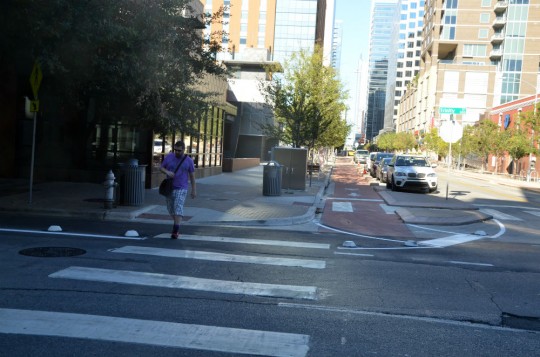
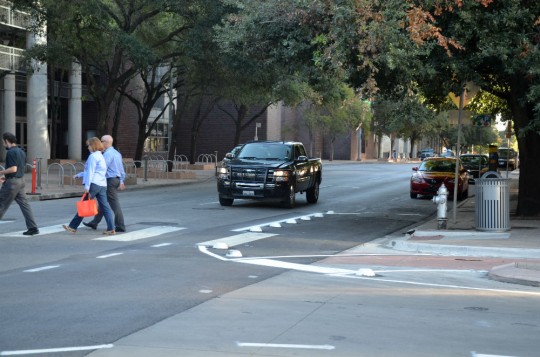
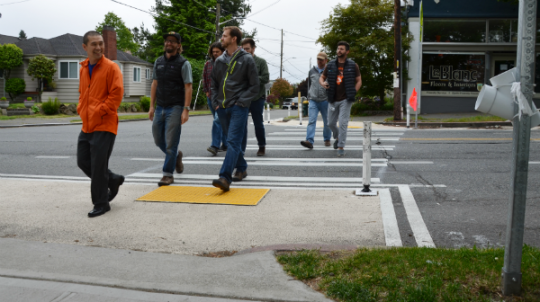
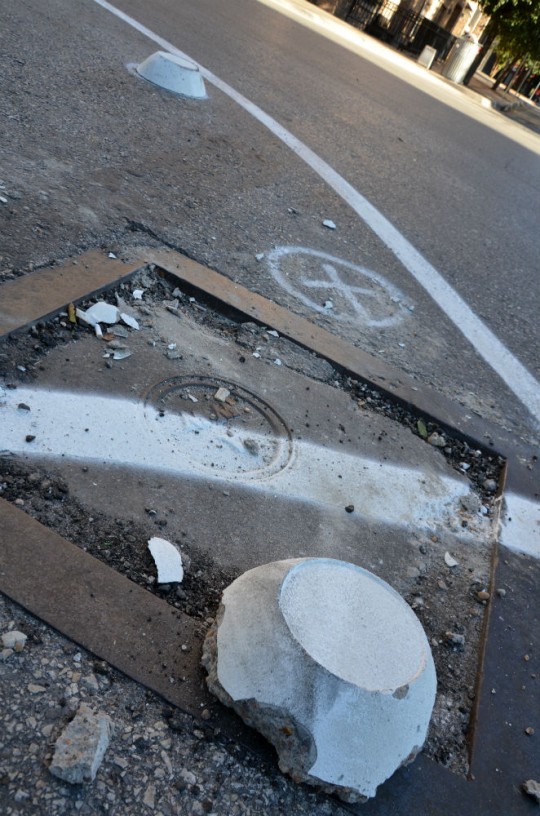
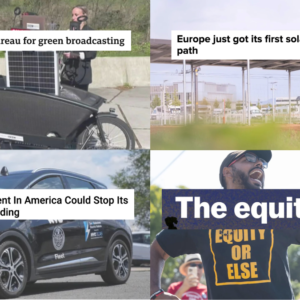
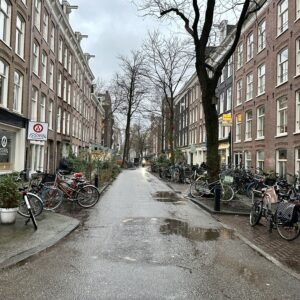
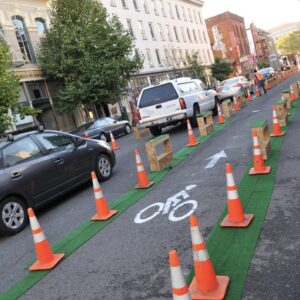
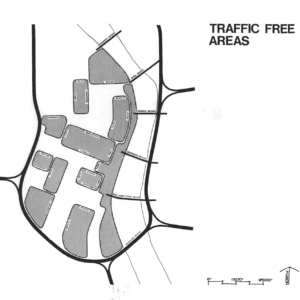
Thanks for reading.
BikePortland has served this community with independent community journalism since 2005. We rely on subscriptions from readers like you to survive. Your financial support is vital in keeping this valuable resource alive and well.
Please subscribe today to strengthen and expand our work.
It’s a good idea, but the bolts won’t make them less fragile. Concrete is rather weak in tension, so the impact that happens in the future is likely to split the concrete, leaving a bolt sticking out of the ground – a more dangerous condition. Keeping the current design seems much safer. Remember that objects placed in the roadway will be hit.
Maybe wire mesh welded to a short bolt, bent rod, or plate with a rod welded to the bottom?
But bumps like this could take down a bike very fast. I prefer plastic bollards or cones, but steel bollards would be safer. These seem to be more optimized for trucks.
The bollards at SW Chestnut and Burlingame work well.
“Remember that objects placed in the roadway will be hit…”
Why should the tax payer should fund this/keep funding this?
Where’s our (real, worthy-of-the-name) gas tax?!
Dont need a gas tax. PBOT and the City have far more than sufficient funds to maintain streets and build new/improved safety elements and bike infrastructure. The City’s elected officials just have to do their jobs to prioritize it.
Oh wait, are you talking about imposing taxes to punish people for driving?
you do like hyperbole.
You say PBOT has more than enough money. Well, maybe. But not if we keep having to spend nearly all of it on cars-only infrastructure. Have you read Whose Roads? by that clever fellow Todd Litman?
http://www.vtpi.org/whoserd.pdf
I really, really wish PBOT would have put these types of curb extensions in rather than the ones they have installed recently.
Such raised objects are a safety concern to PBOT.
“…assuming the placement is careful and the lighting is decent.”
Even these two caveats from the story don’t fully capture all the issues. As we’ve been recently reminded, some cyclists want to take corners ‘at speed’, and these objects are a true hazard in that respect. The low height means they are not seen early if in the shadow of a parked car, but they are rather high if struck by a cyclist. I could see them on a uphill bike lane, but on a downhill? There is also the issue of drunk riders, though I’m disinclined to design for intoxicated road users, it’s still in the back of my mind when designing anything in the roadway.
“Such raised objects are a safety concern to PBOT.”
Huh, I guess that explains why they have put in hundreds of very similar curb extensions. The only real difference is that the ones in Austin are designed for bikes to go through.
The ones here are placed exactly where people ride, when they’re being passed by impatient drivers.
So, the ones PBOT has installed are not any safer, and may in fact be more dangerous. I have personally run into a curb extension (that was not painted, not lighted and not marked correctly) and I ended up with quite a few injuries.
I know that you love to defend PBOT so much, but the design they’re using is significantly worse than Austin’s.
Not having such raised objects is a safety concern to pedestrians and cyclists.
I agree, imaging running your bike over one of these. Is much rather have a curb.
No more of a hazard than the hardscape curb extensions Portland is building. I’ve lost count of the number of cyclists who have told me they injured themselves and/or damaged their bike hitting one, and the same caveats apply regarding placement and lighting. There are some mid-block curb extensions on SE 11th and 12th that are almost impossible to see, and I’m sure that’s not the only location.
A continuous curb extension (bumpout) is a large area of light colored concrete, much easier to see than small raised bumps.
Until the concrete turns black from dirt, leaf tannins, mold and other environmental debris; that takes about one year or less in PDX.
You don’t think a large (several feet long) area of raised concrete bordered by a continuous curb is more visible than a small (several inches) rounded bump, even if both are darkened by dirt etc?. Those little bumps can easily be hidden by leaf litter alone.
I’m not arguing for the bumps, I would prefer neither.
I’ve seen bike lanes protected by those concrete barriers that get used to keep cars from pulling in too far into a parking space, or at least something similar (Boulder I think).
In NYC citibike used something like that at one of their docks, someone hit it, fell, and sued them for $15 million.
http://www.nydailynews.com/new-york/man-sues-nyc-citi-bike-15-million-article-1.1704829
These are what I was saying should be used on 3rd. Ah well.
This may be a good application for the use of fiber-reinforced concrete
Or some kind of resin/plastic product.
I’d almost think of applying this formula:
Locate the apex of the curve and plant a steel/concrete bollard with yellow reflective stripes and a glowing orange light on top. Pedestrians and bicyclists can pass “behind” it in either direction. Only downside would be for long vehicles like buses or trucks—or for the occasional Very Inattentive bicyclist. It seems to work at “bike path” entrances…
I have to say that not every street needs to be built to accommodate our largest trucks. If the streets can’t handle a huge truck, use a smaller one.
I realize this is not a popular sentiment in the freight community, but making streets huge-truck-friendly is making them more dangerous for everyone else (with larger turn radii, longer crossing distances, wider travel lanes, bigger expanses of asphalt, etc.)
Wednesday I saw a huge truck making a turn at NW 25th and Thurman… it barely made it after many forward and back motions and every street stopped for a block in each direction for several minutes…
I wondered how it could even be legal for a vehicle that huge to be on a small street in a dense urban area…
On Hall Blvd, heading Southbound from 99W towards the tracks at Burnham, there used to be a set of tall turtles like these along the bike lane on a right-hand corner that people in vehicles would cut and drive through the bike lane.
The City of Tigard asked ODOT to take them out because they were dangerous to cyclists (preventing us from leaving the bike lane if needed at that corner, like for debris and glass and gravel, a common occurrence).
These big turtles, painted yellow, used to be at the end of Ashford St where it intersects Hall– in place to prevent people cutting through the neighborhood from cutting the corner and hitting oncoming traffic. The turtles have been removed from there as well.
I do like these as a temporary solution for pedestrians, it accomplishes the thing needed (visually narrowing and slowing vehicle traffic) while not blocking completely bicycle traffic.
These “armadillos” as they call them in Texas, are great as a temporary stopgap solution, but should not be used long-term. Just as with the flexible bollards, they will end up destroyed or removed over time as drivers drive into them continuously. A permanent solution could use a curb or bioswales, similar to the cycle track along Naito connecting Lincoln to Harrison.
I would say “s/cycle track/bikeway/”, except that’s a sidewalk.
I could not help noticing how narrow the protected bike lane is and how close the parked cars are to the intersection. I hope that Portland does a better job when it builds a facility downtown.
I think using bioswales as protection would look nicer than bollards and would give an extra Portland flair to our downtown cycle tracks.
Agreed. I’d love sidewalk level, bioswale-protected bike lanes, especially in areas like Vancouver / Williams and SE Hawthorne.
Fully protect the intersections (with bike-specific lights) and see commute share break 10% in less than a year.
There are some roads that have high bike volumes already. We need to recognize that, and design for more.
Aw gee, there was almost a foot of space between the end of the door zone and the seam for the curb apron. Haven’t we been trained to think that a foot is fine by now?
Yikes. No thanks. Those things are easy to not-see and brutal when you hit them (I’ve done both…in quick succession).
What’s more: curb extensions should reduce the crossing distance and offer protection for people walking. Protection from what? Traffic! …and it is well established that WE ARE TRAFFIC.
So: this helps some people who are walking and biking while also creating a hazard for people walking and biking. Bad deal.
I’d be in favor of other creative curb extensions, though. In particular, I think that low planters could provide cheap, visible, meaningful protection without digging up the street.
I”ve got issue with common PBOT install of center islands. Nice in practice for slowing cars, but when you add bicycles to the road, it just creates a conflict for the cyclists. Think SE Clinton, SE Gladstone.
I know the idea of a center island is supposed to calm car speeds, and perhaps it does on average for the length of the whole street, but in my experience, most drivers just grip the steering wheel harder and practice their Nascar driving techniques as they rip around these islands – it’s fun for them. Not safe if a cyclist is going through them, also. Or the cars speed up to cut you off and get through first. And, with all the trees and shrubs in the island, visibility is reduced for actually seeing a pedestrian standing there waiting to cross.
And, typically, the bike lane actually disappears or dips into the gutter storm drain going around the center island, so it creates some idea to the public that the cyclist should get the heck out of the way of the cars.
PBOT just re-striped buffered bike lanes onto N. Smith St (from Roosevelt HS down to Portsmouth/St Louis), which is a street with islands on it. Of course, the buffer areas of the bike lane disappear for 100 feet around the traffic islands and disappear at a couple of intersections. This traffic island area is always the area where you feel like you are going to get creamed by a truck mirror as the cars zip around the island pinch point, and so it is where the bike lane buffer is needed the most, not the least! Just backwards!
PBOT needs to rip out these islands and put the ped refuge between the bike lane and the main travel lane, and not do it with trees and excessive signage which reduce visibility. Just a couple of day-glo bollords stuck to the pavement. So, cars can go straight (and not play Nascar), bikes can go straight and not worry about the pinch points, and peds can have a refuge on both sides that is not a pavement bump in the middle of the road.
New buffered bike lanes are on N Smith St from Columbia Way to St Louis (not Portsmouth).
I saw some interesting alternatives to center islands in rural France. At some small towns/T intersections they use chicanes. They shift the cars over by a lane width with short sections to make the transition, which mean the cars need to slow down to make the chicane. The alternative is hitting curbs and signage.
What? You don’t like to be a human speed bump? Traffic calming, baby!
Where to begin,
Clinton was not a bike street when the neighborhood traffic circles went in (ditto for N Smith). The circles were put there because PBOT did not have bumps as an option back then. The bumps on Clinton are a later addition.
The circles on Gladstone have bike lanes marked around them, so as autos are requirde to shift to go around the circles, so are people on bikes.
I’ve not seen what’s been done to Smith, but it would be poor practice to drop bike lanes in favor of parking to go around the refuge islands.
Refuge islands are constructed in the middle of busy roads to break the crossing into two halves. The two-phase crossing is safer for the youngest and oldest pedestrians because they only have to find a gap in one direction of auto traffic. Your suggestion would result in less safe pedestrian crossings.
So you’re saying that Clinton, Gladstone, Smith are busy streets that require splitting the pedestrian crossing into 2 parts of the street in order to be safe? I don’t agree. These islands create more safety issues for cyclists than they solve for pedestrians. On these streets, the poor choices made in the past should be removed and upgraded to better ones. There seems to be plenty of money for curb changes in the PBOT budget, and this is not a big expense to improve/upgrade. Have you ever been passed on your bike by a speeding car while going around the island? These are pinch point bottle necks that create unsafe conditions for cyclists.
Traffic circles are not refuge islands.
Smith has refuge islands. Clinton and Gladstone have traffic circles. Gladstone also has one or two refuge islands. Circles were used to slow down cars before bumps were approved for that purpose.
Consider the needs of a child walking to school.
Smith near Oswego has about 2,500 trips per day.
Gladstone has over 4,000.
I hate the SE Gladstone circles because they cause the bike lane to angle at them and people are always parked in the angled spots of those bike lanes which forces the bikes into the motor vehicle lane where space is already tight…
enforcement!
And, of course, you’ve called 823-SAFE when you see them, right?
“Betcha nobody misses one twice” Welcome to Texas humor.
there is a terrible one at ne122nd & Glisan (by Mcdonalds) … it forces bikes out into traffic for about 8-10 feet. many close calls there.
Needs to be torn up and redone. 🙁
Curious,
the street view shows no such requirement.
https://goo.gl/maps/QWqDbJ7YLAv
There are no bike lanes on Glisan and the bike lane on 122nd clearly is next to the curb extension.
I’m looking right at it in the street view you provided. To the east on Glisan, the right lane allows lane sharing. As you cross the intersection (heading west on Glisan) the bulb out reduces the lane to substandard width for 8 – 12 feet and then goes right back to being a very shareable width lane.
This, right?
http://i.imgur.com/9I1BSoN.jpg
D,
The curb parking lane is not a bike lane. If you choose to ride in a parking lane, you might expect to find objects there from time to time.
You’re riding in empty car parking space. Hardly anyone parks on Glisan because of the traffic speeds, which is also why it probably isn’t the best idea to ride on Glisan. I’m sure you’ve encountered parked cars, right?
I’m not riding there at all nor have any experience with the intersection. I was simply pointing out what SE was describing. If paikiala chooses to play the ***personal insult deleted by moderator*** that’s his prerogative.
I have come to the conclusion that Ptown cylists, at least a lot of them, have come to expect limo level bike infra and will accept nothing less. Need proof? Check the comments above.
Compared to what is out there, the Austin improvements are impressive. PBOT’s asenine “safety” reasons aside for not doing something, the real reason is usually cost. The reality is, armadillos or really anything work well. I can navigate an armadillo just fine. They are all over the place up around Olympia and can be replaced in a few minutes.
Curbs crack and fail requiring thousands in repair. One little armadillo, a few minutes and a few bucks.
But..limo riders want the world. I’ll take my few feet of space protected by something just a bit more than paint.
Why is it that car drivers and people walking get world-class facilities but people riding bikes get stuck with paint?
Because that’s only method that most cyclists can agree on. See comment above “I hate diverters”.
Please identify the so-called world class road network or roadways here in Portland. Lets not overstate the case to arouse emotional support.
http://i.imgur.com/4tHy7cT.jpg
What does world class even mean?
FYI, the picture in this article depicts *almost” a dutch style intersection. Almost.
There are many good reasons to install curb extensions, but I feel like Portland is often too quick to install them without thinking about the long term consequences. I was browsing through the 100% Construction Document set for the Twenties Bikeway last night, and was struck by how many curb extensions or median islands they’re installing that will make building out the 2030 Bike Plan much more difficult and expensive. A few examples, from North to South:
– The curb extension at NE Alberta / 32nd will block the obvious location for bike lanes on Alberta.
– The curb extension at NE Wasco / 28th will block a future southbound bike lane on 28th.
– The two way cycletrack on the south side of E Burnside and 30th doesn’t seem designed with the possibility of bike lanes along the rest of Burnside in mind
– The median islands at SE Belmont and 29th creates a pinch point between cars and bikes, and will make it more difficult to add bike lanes on Belmont.
^^^^^This!^^^^^
mac – do you have a link to those construction documents?
thnx!
ftp://ftp02.portlandoregon.gov/PBOT/CDS/T00338%20Twenties%20Bikeway/100_perc.pdf
Thanks! Probably a topic for a whole ‘nother story, but I am very, very puzzled by some of the route choices in this plan; the route follows streets I would never think of riding on due to either very steep topography or very poor pavement conditions, when there are better alternative routes just a few blocks over which are already designated as bike routes. In particular, I’m looking at the section between SE Powell and SE Belmont, but this also applies to other sections further north, including through the Burnside/28th business district.
PBOT doesn’t really seem to care at all about the 2030 bike plan.
I’ve been trying for years to get PBOT to make real any of the bike infrastructure that was promised and they haven’t.
And it’s not just funding that’s holding them back, either. They are too weak against “politically difficult” situations.
Just because your list of preferences isn’t being constructed doesn’t mean PBOT is ignoring the 2030 plan:
N Central Greenway
N Wabash Greenway
N Bryant Greenway
NE Bryant Greenway
N Michigan Greenway
N Houghton Greenway
N Concord Greenway
NE 87th Greenway
NE Holman Greenway
NE Klickitat Greenway
NE Sacramento/77th Greenway
N Vancouver/Williams
N Going Greenway
NE Going Greenway
SE Spokane Greenway
SE Bush Greenway
SE Center Greenway
SE 19th Greenway
SE 87th Greenway
SE 100/101 Greenway
SW Westwood Greenway
SW Illinois Greenway
SW Vermont Greenway
SW Maplewood/Miles Greenway
50’s bikeway
20’s bikeway
Clinton upgrade to NG standards
‘Greenways’ on low-traffic streets are the low-hanging fruit, but most of them are already perfectly safe to ride on without any of the so-called PBOT ‘improvements’.
How many of those are comfortable to ride down?
Not only are many of them filled with bad pavement, many have high car volumes, high car speed and very little physical protection from distracted drivers.
In many cases,, bike lanes end at intersections or in areas that have high volumes of car traffic.
Most don’t have safe crossings of arterial streets and neighborhood collectors.
Many have mixing zones that can be very dangerous.
This is very different than what the plan called for. We have sharrows where there should be lanes, lanes where there should be cycle tracks and nonexistent infrastructure where there should be completely grade separated paths.
And the “progress” that has been made has not been enough for the thousands of people who easily could and would ride. I know people who will drive 10 blocks instead of biking because the direct way is deadly, and the “official” route is 3 times longer.
Right or wrong, “armadillos” look like lawsuits to me.
I’m not sure that standing behind something that motorists “usually” avoid would bring me any sense of safety. As a pedestrian, these bumps are pointless.
As for the bike lanes… every single problem that incomplete or poorly designed bike lanes create can be solved by riding in the traffic lane. You’re slowly but surely striping yourselves down from 2nd to 3rd class citizens.
and there’s an ADA (for lack of better term) curb at se 122nd & Stark that juts out far enough that the majority of right turning vehicles run over it.
Pushes bikes out into traffic.
Another poor implementation by PBOT